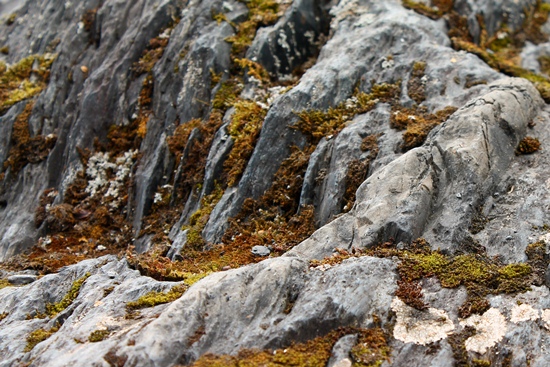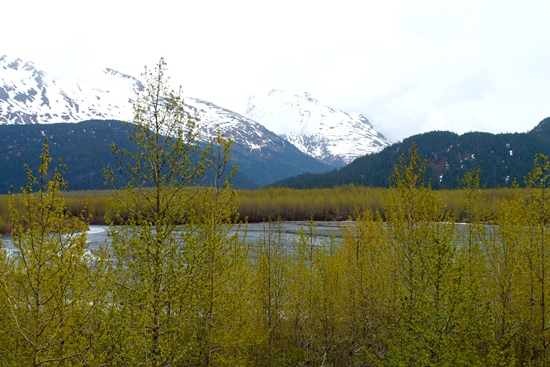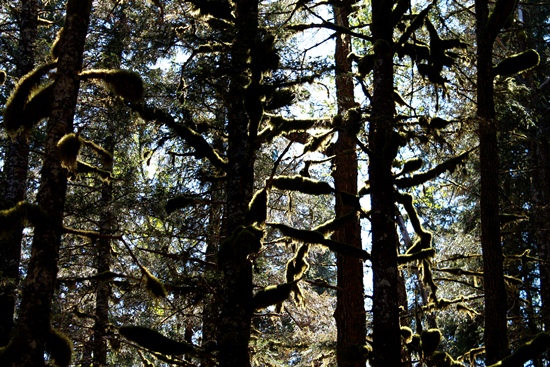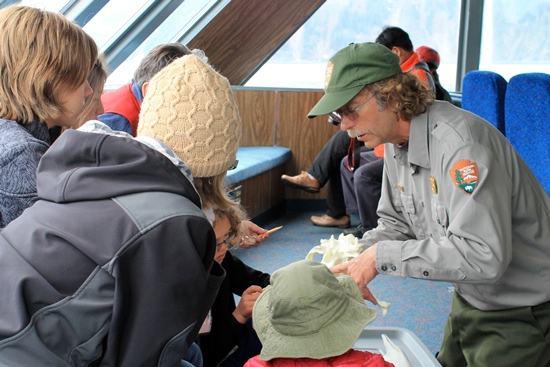Mosses and Lichens near Exit Glacier. PHoto: NPS / Max Odland
It's nearly impossible to miss how much the landscape changes over the course of the short walk from the Nature Center at Exit Glacier to the glacier itself. You might notice it in fits and starts, when the trees suddenly get small enough peer between with ease, or when you emerge onto the hillside and see them replaced by occasional shrubs poking out of a patchy moss carpet. But if you pay close enough attention you can see the entire developmental gradient of the forest—a sliding scale from freshly uncovered ground to mature rainforest*. And all you have to do is keep your eyes open as you walk to see how it plays out. You don't even need your eyes, really. You can hear, smell, and feel the differences just as easily.
*To be fair, none of the trails pass through a mature spruce-hemlock rainforest. But you can see them in the distance, so I'm counting it.
Young black cottonwood forest near Exit Glacier, with a (darker) Sitka spruce forest in the background. Photo: NPS / Max Odland
In Ecology, this process in which a natural community changes following a disturbance like a fire, a landslide, or a large storm is called succession. Succession usually refers to the plant community, but animals follow their food so they're never far behind. Around here, the most obvious form of succession happens on the land glaciers uncover as they retreat. Glaciers scrape the land clean of soil, effectively creating a blank slate. Species move back in, starting immediately with a few hardy, sun-loving pioneers like lichens, mosses, and fireweed. These species release nutrients from the rocks and create small amounts of soil, letting the slightly-less-hardy colonizers like alder and cottonwood move in. Eventually this second wave gives way to longer-living and more shade tolerant species, Sitka spruce and western hemlock in this case.
Sitka spruce forest, the "climax community" in this region. Photo: NPS / Max Odland
Ecologists believed for a long time that after a certain amount of time passes, the natural community returns to a stable state called the "climax community". That concept has fallen to the wayside more recently because we've realized that the resulting community is anything but stable. Firstly, the make-up of any community changes over time in response to changes in climate and species migration. A natural, mature forest today might have entirely different species than the natural, mature forest that was in the same place several thousand years ago. Secondly, local disturbances continue to shape the mature community constantly. Perhaps a winter ice storm snaps the top from a tree, or a river jumps its course after a rainstorm, washing away the plants and soil on its banks. These smaller disturbances create a patchwork of communities—everything from bare rock to mature forest—that together form a healthy and diverse landscape.
Another thing that's hard to miss is the large number of young people at Kenai Fjords. Infants and toddlers visiting the park with their parents, perched in strollers or baby backpacks; Children and adolescents enthusiastically (or sometimes shyly) becoming junior rangers; Crews of high school students making trail improvements; and finally the numbers of young adults working for the Park Service.
A Kenai Fjords National Park ranger with prospective junior rangers. Photo: NPS / Max Odland
Looking at these young people in the park, I can't help but think there's another succession going on here, parallel to the forest's growth. It starts with simply getting outside and experiencing the natural world. From there, a sense of appreciation can form, and grow toward stewardship. Maybe the same child isn't going to come back to Exit Glacier enough for the entire process to take place here, but even so we're playing an important part. Whatever stage they (Or rather we, as a young person interning with the Park Service) arrive at, there's something here to take us a little further.




